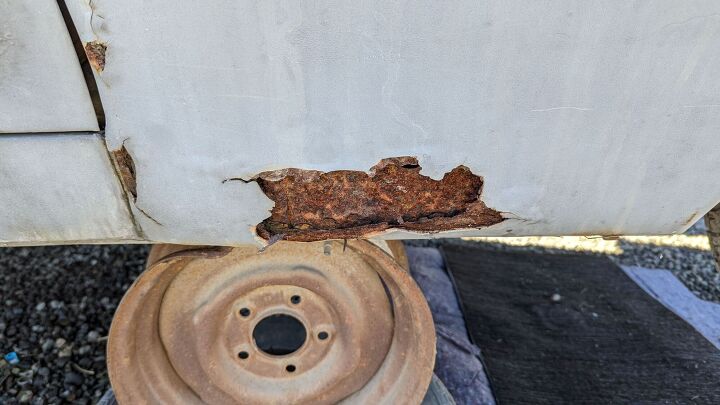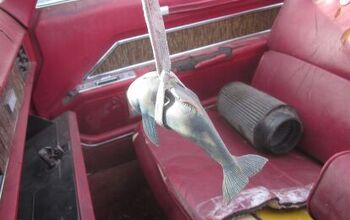Junkyard Find: 1967 Cadillac Calais Coupe

It's still no sweat to find Malaise Era Cadillacs in the big California self-service car graveyards these days, but the sleek and powerful Cads of the mid-to-late-1960s don't show up in such places so often. That makes this 1967 Cadillac Calais Coupe, found in a yard just up I-880 from the Tesla Factory last month, a very special Junkyard Find.
Yes, it's glorious!
A Pick-n-Pull yard will most often have a "builder" lot near the entrance, with complete cars sold for cheap with salvage titles; those that don't sell after a few weeks get put in the regular parts yard. It appears that $1,849 just wasn't cheap enough.
It's definitely a 50-footer, with plenty of thick primer over body filler over rust.
Then there's the sketchy-looking replacement VIN tag from the State of California, the sight of which would send a chill down the spine of anyone who has ever dealt with a lien-sale or salvage car at the Golden State's DMV (as I have, many times). I've always assumed that the employees there are subjected to waterboarding (or worse) from knee-breaking heavies sent out from Sacramento if they say yes to a customer, while they get bonuses for saying no. I hear that the Massachusetts DMV is worse, but I find that hard to believe.
The Calais was the entry-level Cadillac from the time the Sixty-Two name got dumped (1965) until the Nova-based Seville appeared (1976). The city of Calais isn't quite as ritzy as Biarritz, but the name sounds sufficiently French and therefore classy.
The build tag on the firewall says this car was built at the Fleetwood Body Plant in Detroit during the second week of February 1967. The original color was Baroque Gold. We can assume that it has been through many owners and has been driven many miles.
We can't know exactly how many miles, however, because of the five-digit odometer.
While the Calais was the lowest-priced new Cadillac for 1967, that doesn't mean it was meant for Olds-driving proles. The base price for this car was $5,040, which comes to about $45,505 in 2022 dollars. The Coupe de Ville started at $5,392 ($48,790 now).
The differences between the Calais and the very similar-looking de Ville were to be found in the standard equipment and available options. You couldn't get leather upholstery in the '67 Calais, for example, and you had to pay extra if you wanted such standard-on-the-de Ville items as power seats.
Cadillac was still king of the American road in 1967, so that was a lot of swank per dollar.
The thermostat-controlled HVAC was standard equipment in the '67 Calais, but that AM/FM radio added 188 bucks ($1,700 today) to the price tag. If you wanted your FM in stereo, that cost $288 ($2,605 after inflation).
The interior is rough but mostly there (the door panels were in the trunk). Still, body and interior work on this car would cost a lot more than what you'd pay for a nice Calais.
All Cadillacs still had genuine Cadillac engines during the 1960s; if this is the original one, it's a 429-cubic-incher (7.0 liters) rated at 340 horsepower and an amazing 480 pound-feet of torque (sadly, these are gross, not net numbers; they'd be a lot lower if measured by current standards).
Despite making such big power, the 390-series Cadillac V8 weighed just a bit more than the small-block Chevrolet V8. All 1967 Cadillac models got the same engine.
A three-speed automatic was the only transmission available. If you wanted a manual Cadillac, you had to wait until the Cimarron and its base four-on-the-floor appeared for the 1982 model year.
You can see the remains of a Class of '86 tassel among the verdigrised pennies on the carpeting. I think this car sat for quite a while.
However, these 22-inch wheels and tires must have gone on during the last couple of decades at most. Look at that, the fender skirts are still there!
This being the Bay Area, we can assume that this car had a final owner who wanted to scraper-ize a classic Cadillac. This Royal D/Richie Rich song didn't get much attention outside of the East Bay, but it deserved to be a global hit (if only for its lyrics about the 60k-mile blue Buick Park Avenue).
It will be crushed soon enough, but let's hope many of its parts live on in other cars.
Cadillac built just over 20,000 Calais cars for 1967, while making nearly 140,000 de Villes. Eventually, GM decided that the Buick Division could sell Electras and Rivieras to potential Calais buyers and killed the model.
[Images: The author]
Become a TTAC insider. Get the latest news, features, TTAC takes, and everything else that gets to the truth about cars first by subscribing to our newsletter.

Murilee Martin is the pen name of Phil Greden, a writer who has lived in Minnesota, California, Georgia and (now) Colorado. He has toiled at copywriting, technical writing, junkmail writing, fiction writing and now automotive writing. He has owned many terrible vehicles and some good ones. He spends a great deal of time in self-service junkyards. These days, he writes for publications including Autoweek, Autoblog, Hagerty, The Truth About Cars and Capital One.
More by Murilee Martin
Latest Car Reviews
Read moreLatest Product Reviews
Read moreRecent Comments
- Oberkanone The alternative is a more expensive SUV. Yes, it will be missed.
- Ajla I did like this one.
- Zerofoo No, I won't miss this Chevrolet Malibu. It's a completely forgettable car. Who in their right mind would choose this over a V8 powered charger at the rental counter? Even the V6 charger is a far better drive.
- Offbeat Oddity Nope, I won't miss it. I loved the 2008-2012 Malibu, but the subsequent generations couldn't hold a candle to it. I think the Impala was much more compelling at the end.
- Zerofoo An almost 5000 pound hot hatch that fell out of the ugly tree and hit every branch on the way down? No thanks.



















































Comments
Join the conversation
"The Calais was the entry-level Cadillac from the time the Sixty-Two name got dumped (1965) until the Nova-based Seville appeared (1976)."
Um, the Seville was priced higher than every other Cadillac model, save the 75-series Limousine.
The Seville was hardly "entry level".
We always called it the "cheap Calais". And who put a Holley on that 429? Blasphemy!